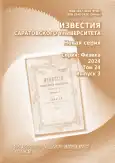Tight-binding implementation of the quantum kinetic equation for graphene
- Authors: Panferov A.D.1, Shcherbakov I.A.1
-
Affiliations:
- Saratov State University
- Issue: Vol 24, No 3 (2024)
- Pages: 198-208
- Section: Physics of Condensed Matter
- URL: https://journals.rcsi.science/1817-3020/article/view/265411
- DOI: https://doi.org/10.18500/1817-3020-2024-24-3-198-208
- EDN: https://elibrary.ru/EWJDQE
- ID: 265411
Cite item
Full Text
Abstract
About the authors
Anatolii Dmitrievich Panferov
Saratov State University
ORCID iD: 0000-0003-2332-0982
Scopus Author ID: 24384266800
ResearcherId: AAO-7735-2021
410012, Russia, Saratov, Astrakhanskaya street, 83
Ilya A. Shcherbakov
Saratov State University
ORCID iD: 0009-0003-0599-3099
410012, Russia, Saratov, Astrakhanskaya street, 83
References
- Higuchi T., Heide Ch., Ullmann K., Weber H. B., Hommelhof P. Light-field-driven currents in grapheme // Nature. 2017. Vol. 550. P. 224–228. https://doi.org/10.1038/nature23900
- Aryasetiawan F., Gunnarsson O. The GW method // Rep. Prog. Phys. 1998. Vol. 61. P. 237. https://doi.org/10.1088/0034-4885/61/3/002
- Golze D., Dvorak M., Rinke P. The GW Compendium: A Practical Guide to Theoretical Photoemission Spectroscopy // Frontiers in Chemistry. 2019. Vol. 7. Article number 377. https://doi.org/10.3389/fchem.2019.00377
- Provorse M. R., Isborn Ch. M. Electron Dynamics with Real-Time Time-Dependent Density Functional Theory // International Journal of Quantum Chemistry. 2016. Vol. 116 P. 739–749. https://doi.org/10.1002/qua.25096
- Mocci P., Malloci G., Bosin A., Cappellini G. Time-Dependent Density Functional Theory Investigation on the Electronic and Optical Properties of Poly-C,Si,Ge-acenes // ASC Omega. 2020. Vol. 5. P. 16654–16663. https://doi.org/10.1021/acsomega.0c01516
- Wilhelm J., Grössing P., Seith A., Crewse J., Nitsch M., Weigl L., Schmid Chr., Evers F. Semiconductor Bloch-equations formalism: Derivation and application to high-harmonic generation from Dirac fermions // Phys. Rev. B. 2021. Vol. 103. Article number 125419. https://dx.doi.org/10.1103/PhysRevB.103.125419
- Ornigotti M., Carvalho D. N., Biancalana F. Nonlinear optics in graphene: Theoretical background and recent advances // La Rivista del Nuovo Cimento. 2023. Vol. 46. P. 295–380. https://doi.org/10.1007/s40766-023-00043-8
- Novoselov K. S., Geim A. K., Morozov S. V., Jiang D., Katsnelson M. I., Grigorieva I. V., Dubonos S. V., Firsov A. A. Two-dimensional gas of massless Dirac fermions in graphene // Nature. 2005. Vol. 438. P. 197–200. https://doi.org/10.1038/nature04233
- Castro Neto A. H., Guinea F., Peres N. M. R., Novoselov K. S., Geim A. K. The electronic properties of graphene // Rev. Mod. Phys. 2009. Vol. 81. P. 109–162. https://doi.org/10.1103/RevModPhys.81.109
- Katsnelson M. I. The Physics of Graphene. Cambridge University Press, 2020. 425 p. https://doi.org/10.1017/9781108617567
- Гриб A. A., Мамаев С. Г., Мостепаненко В. М. Вакуумные квантовые эффекты в сильных полях. М. : Энергоатомиздат, 1988. 288 с.
- Bialynicky-Birula I., Gornicki P., Rafelski J. Phase space structure of the Dirac vacuum // Phys. Rev. D. 1991. Vol. 44. P. 1825–1835. https://doi.org/10.1103/PhysRevD.44.1825
- Schmidt S. M., Blaschke D., Röpke G., Smolyansky S. A., Prozorkevich A. V., Toneev V. D. A Quantum kinetic equation for particle production in the Schwinger mechanism // Int. J. Mod. Phys. E. 1998. Vol. 7. P. 709–718. https://doi.org/10.1142/S0218301398000403
- Blaschke D. B., Prozorkevich A. V., Röpke G., Roberts C. D., Schmidt S. M., Shkirmanov D. S., Smolyansky S. A. Dynamical Schwinger effect and high-intensity lasers. Realising nonperturbative QED // Eur. Phys. J. D. 2009. Vol. 55. P. 341–358. https://doi.org/10.1140/epjd/e2009-00156-y
- Panferov A., Smolyansky S., Blaschke D., Gevorgyan N. Comparing two different descriptions of the I–V characteristic of graphene: Theory and experiment // EPJ Web Conf. 2019. Vol. 204. Article number 06008. https://doi.org/10.1051/epjconf/201920406008
- Smolyansky S. A., Panferov A. D., Blaschke D. B., Gevorgyan N. T. Nonperturbative kinetic description of electron-hole excitations in graphene in a time dependent electric field of arbitrary polarization Particles. 2019. Vol. 2. P. 208–230. https://doi.org/10.3390/ particles2020015
- Smolyansky S. A., Blaschke D. B., Dmitriev V. V., Panferov A. D., Gevorgyan N. T. Kinetic equation approach to graphene in strong external fields // Particles. 2020. Vol. 3. P. 456–476. https://doi.org/10.3390/particles3020032
- Панферов А. Д., Новиков Н. А. Характеристики индуцированного излучения в условиях действия на графен коротких высокочастотных импульсов // Известия Саратовского университета. Новая серия. Серия : Физика. 2023. Т. 23, вып. 3. С. 254–264. https://doi.org/10.18500/1817-3020-2023-23-3-254-264
- Церюпа В. А., Чурочкин Д. В., Дмитриев В. В., Смолянский С. А. Излучение в графене: кинетический подход // Журнал технической физики. 2024. Т. 94, вып. 3. С. 351–357. https://doi.org/10.61011/JTF.2024.03.57371.1-24
- Wallace P. R. The Band Theory of Graphite // Phys. Rev. 1947. Vol. 71. P. 622–634. https://doi.org/10.1103/PhysRev.71.622
- Martin P. C., Schwinger J. Theory of many-particle systems. I // Phys. Rev. 1959. Vol. 115. P. 1342–1373. https://doi.org/10.1103/PhysRev.115.1342
- Ахиезер A. И., Пелетминский С. В. Методы статистической физики. М. : Наука, 1977. 367 с.
- Sipe J. E., Shkrebtii A. I. Second-order optical response in semiconductors // Phys. Rev. B. 2000. Vol. 61. P. 5337–5352. https://dx.doi.org/10.1103/PhysRevB.61.5337
- Ishikawa K. L. Nonlinear optical response of graphene in time domain // Phys. Rev. B. 2010. Vol. 82. Article number 201402. https://doi.org/10.1103/PhysRevB.82. 201402
- Yoshikawa N., Tamaya T., Tanaka K. High-harmonic generation in graphene enhanced by elliptically polarized light excitation // Science. 2017. Vol. 356. P. 736–738. https://doi.org/10.1126/science.aam8861
- Sato Sh. A., Hirori H., Sanari Y., Kanemitsu Y., Rubio A. High-order harmonic generation in graphene: Nonlinear coupling of intraband and interband transitions // Phys. Rev. B. 2021. Vol. 103. Article number. L041408. https://dx.doi.org/10.1103/PhysRevB.103.L041408
- Reich S., Maultzsch J., Thomsen C. Tight-binding description of grapheme // Phys. Rev. B. 2002. Vol. 669. Article number 035412. https://dx.doi.org/10.1103/PhysRevB.66.035412
- Панферов А. Д., Поснова Н. В., Ульянова А. А. Моделирование поведения двухуровневой квантовой системы с использованием масштабируемых регулярных сеток // Программные системы: теория и приложения. 2023. Т. 14, вып. 2. С. 27–47. https://doi.org/10.25209/2079-3316-2023-14-2-27-47
- Gil-Villalba A., Meyer R., Giust R., Rapp L., Billet C., Courvoisier F. Single shot femtosecond laser nanoablation of CVD monolayer graphene // Scientific Reports. 2018. Vol. 8. Article number 14601. https://dx.doi.org/10.1038/s41598-018-32957-3
- Weitz T., Heide Chr., Hommelhoff P. Strong-Field Bloch Electron interferometry for Band Structure Retrieval // arXiv:2309.16313v1. https:// doi. org/10.48550/arXiv.2309.16313
Supplementary files









